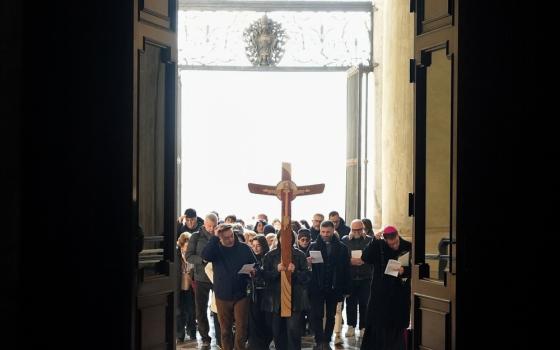At noon Friday, a group of prominent Catholics released a letter to Health & Human Services Secretary Kathleen Sebelius recommending that she amend the proposed rule on mandated health care coverage to provide for more expansive conscience protections for religious organizations. The letter is signed by some of the same academics who penned a letter to Speaker of the House John Boehner in advance of his commencement address at Catholic University in May, calling on him to support policies that reflect Catholic social teaching. The main organizer of both letters is Professor Stephen Schneck, Director of CUA’s Institute for Policy Research & Catholic Studies.
In addition to academics such as Schneck, Georgetown’s Rev. Thomas Reese, S.J., Lisa Sowle Cahill of Boston College, Margaret Steinfels of Fordham and Duquesne University law professor Nicholas Cafardi, the letter is signed by former Congresswoman Kathy Dahlkemper, one of the pro-life Democrats unseated in last year’s midterm elections as well as Kristen Day, executive director of Democrats for Life, and Sr. Simone Campbell of the social justice group NETWORK. These are the kinds of Catholics that the Obama administration has reached out to in the past, especially during the battle over health care reform, and so the impact of their call for more expansive conscience protections is likely to be heard in the White House. Indeed, the full list reads like a "Who's Who" of prominent Catholics whose politics tilt to the left.
The letter will be delivered to Secretary Sebelius formally and will be submitted under the guidelines governing public comment on the new rule, which was announced August 1 with a 60-day comment period. The full text of the letter follows.
Dear Secretary Sebelius,
We are an ad hoc group of Catholic leaders and professors, many of whom were associated with the letter addressing Speaker Boehner’s legislative commitment to the poor ahead of his commencement address at The Catholic University of America in May. We write to you, however, to advocate enlarging conscience protections in the mandated insurance programs of the Affordable Care Act.
The Institute of Medicine’s recent determination that insurance mandated by the Affordable Care Act must extend contraception coverage in all plans—to include even post-fertilization drugs and sterilization—raised conscience protection concerns for a number of religious organizations. In response to those concerns, Health and Human Services (HHS) has proposed interim final rules that do provide limited exemptions to religious organizations. However, those exemptions as currently proposed would not extend to many important religious organizations.
The current language limits conscience protection to organizations that 1) have the inculcation of religious values as their purpose; 2) primarily employ those that share their religious tenets; 3) primarily serve persons who share their religious tenets; and 4) are a non-profit organizations. This language is too restrictive.
Catholic charities and Catholic hospitals do not fit the rule’s definition of religious organization. Catholic schools, colleges, and universities also might not fit the current definition. In light of the First Amendment’s protection of religious practice and of the 1964 Civil Rights Act’s forbidding of discrimination for religious belief and insistence on accommodation of religion in the workplace, we propose expanding the definition of religious organization in the final rule to extend conscience protection to religious charities, religious hospitals, and religious schools in regards to mandated health insurance coverage.
Title 26 of the United States Code offers appropriate guidance for defining religious organizations. The HHS interim rule references Title 26 for such consideration. Accordingly, we propose defining a religious organization as one meeting the following criteria:
If it 1) is non-profit religious, educational, or charitable organization; 2) if it engages its religious, charitable, or educational activities for bona fide religious purposes or reasons; and if 3) it holds itself out to the public as a religious organization.
Courts have applied a similar set of criteria in various contexts and have found that organizations should be exempt as "religious" because their charitable or educational activities were deeply religiously motivated, even though those activities did not primarily involve explicit proselytizing or teaching of religion and were not limited to members of the faith community in question. See, e.g., Spencer v. World Vision, Inc., 633 F.3d 723 (9th Cir. 2011) (en banc) ("religious organization" exempt under Title VII; evangelical Protestant humanitarian relief agency); LeBoon v. Lancaster Jewish Community Center Assn., 503 F.2d 217 (3d Cir. 2007) (same Title VII exemption for Jewish-oriented community organization); University of Great Falls v. NLRB, 278 F.3d 1335 (D.C. Cir. 2002) (ecumenically oriented Catholic college protected from NLRB jurisdiction over faculty); Universidad Cent. de Bayamon v. NLRB, 793 F.2d 383 (1st Cir. 1985) (Breyer, J.) (Catholic college; NLRB jurisdiction over faculty). As the court stated in Great Falls, 278 F.3d at 1346, limiting "exemption to religious institutions with hard-nosed proselytizing, that limit their enrollment to members of their religion, . . . is an unnecessarily stunted view of the law, and perhaps even itself a violation of the most basic command of the Establishment Clause-not to prefer some religions (and thereby some approaches to indoctrinating religion) to others."
Secretary Sebelius, the language of Title 26 more fully reflects the intentions of the First Amendment and the Civil Rights Act as they pertain to matters of religious conscience. In regard to the mandated insurance coverage of the Affordable Care Act, the language of Title 26 would extend conscience protections to religious organizations on the front lines of the Catholic Church’s ancient mission to the poor and the sick.




